Almost three years after the College Park Academy opened its doors to its first class of sixth grade students, the academy’s online “bricks and clicks” curriculum is proving itself with high student test scores, said Sen. Jim Rosapepe (D-Prince George’s and Anne Arundel), former first chairman of the school’s board of directors.
The academy, located on Adelphi Road in Prince George’s County, follows a “totally different” curriculum than the county’s public schools, said Bernadette Ortiz-Brewster, the academy’s principal. The students’ materials, including textbooks, assessments and other resources, are all available online, she said. The academy currently offers sixth through ninth grade classes — it plans to add a grade each year to expand into a middle and high school academy — and follows a “bricks and clicks” motto, meaning learning is done both inside the building and on the computer.
During the 2014-15 academic year, the eighth grade students enrolled at the academy scored a higher average on the 8th grade science Maryland School Assessment than the county, state and surrounding districts, Ortiz-Brewster said. The academy scored an average of 83 percent, compared to the state’s 68 percent overall average. Prince George’s County scored an average of 52 percent, Howard County scored 82.5 percent and Montgomery County scored 75.4 percent.
In addition to these scores, the 2014-15 eighth graders scored a 69 percent average on the Algebra I exam, while average test scores for Prince George’s County’s high school students was 37 percent for the same exam. The academy used eighth grade scores for comparison with other schools because it did not have high school students yet at that time.
University President Wallace Loh, who serves on the academy’s board of directors, said he is very proud of the academy and the students’ exemplary test scores.
“It’s a great opportunity for our students who want to work with kids or go into education, and I think the whole university learns from this blended education model,” Loh said. “I think it’s successful beyond anybody’s dreams.”
Rosapepe said the academy’s scores don’t surprise him, as he supports the school’s curriculum and overall vision.

The College Park Academy’s 2014-15 8th grade students scored higher than average on the science Maryland State Assessment compared to the county, state and surrounding districts. (Graphic by Julia Lerner/The Diamondback)
“There are a lot of very bright, hard-working kids in P.G. County, and we’ve got a very skilled, focused staff at the school who are committed to the vision, who are committed to rigorous college preparation, who are committed to personalized instruction, which is what you can do with ‘bricks and clicks,'” he said.
Ortiz-Brewster attributes much of this success to the support system and resources from board members, as well as Connections Education, a subsidy of Pearson, which provides the school’s curriculum, she said.
The academy’s board of directors is composed of 15 members from the city, county and university.
“I reach out to individual board members all the time for guidance and their willingness to help is really comforting,” Ortiz-Brewster said. “Also, they provide us with resources from the university … resources like interns and after-school programs where UMD students are coming to work with our students.”
This school is a great opportunity for the families and their kids living in the area, College Park Mayor Patrick Wojahn said. Brian Ullmann, a university spokesman, also noted that the academy is an essential part of the Greater College Park vision because, “If you want people to move here, you’ve got to provide some schools.”
“One of our greatest challenges in College Park is making sure that people of the city have access to quality education for their kids,” Wojahn said. “I think [the] academy, while far from solving [this] problem, helps give parents more options. It’s a great option right near the city.”
Ortiz-Brewster also said she is “appreciative” of the county’s willingness to allow the academy to be “innovative,” which “gives [them] an opportunity to think outside the box and try new things.”
The academy’s online curriculum, for example, allows students to utilize resources such as videos, giving them more practice, Ortiz-Brewster said. The online feature also enables parents to access their child’s grades, which Ortiz-Brewster said provides extra accountability for the students.
“The really cool thing about that is that the parents will have an account,” she said. “I think that not only is that providing transparency to the family, but they can see exactly what’s going on. … So that transparency I think really helps.”
Yet despite the academy’s unique structure, at the end of the day, students are getting out what they’re putting in, Ortiz-Brewster said.
“It’s no miraculous formula,” she said. “Basically, it’s just a lot of work.”
Staff writer Hannah Lang contributed to this report.



